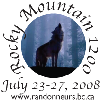Rules
- Riders must obey all traffic laws.
- Approved bicycle helmets must be worn at all times during the ride. Riders observed riding without a helmet will be disqualified.
- Bicycles must be in safe working order. A front white headlight visible for at least 150 metres to oncoming traffic and a red tail light visible to following traffic are mandatory - no lights means no ride. Lights must be attached to the bike and in good working order. Flashing tail lights will be permitted when riding alone. When riding in a group, a solid red tail light should be used if any member of the group objects to the use of flashing lights. A head lamp is recommended for reading the route sheet at night.
- Spare batteries and adequate alternate lightings systems must be carried by riders throughtout the ride.
- When riding between sunset and sunrise, riders must wear a reflective vest or reflective sash and reflective leg bands. A reflective rear triangle and additional reflective on the helmet and cranks is recommended but not mandatory.
- Each rider must check in at every control and get his/her control card stamped or signed, with the time clearly printed, by control personnel. Failure to have the required signature from each control along the route will result in disqualification. When stopping to rest at a control, riders should also check out as a courtesy to help the organizers track each rider's progress.
- No following vehicles are permitted. Riders must not receive support except at a control point (in addition, riders of the Rocky Mountain 1200 may receive support at Saskatchewan River Crossing and at Rogers Pass). Riders must be prepared for mechanical mishaps, changes in weather, etc. This does not mean that riders cannot borrow tools, or receive help in changing a tire, from other participants. ( See Understanding the No En Route Support Rule below). Riders supported by crews that fail to abide by the rules will be disqualified.
- Riders who stray off course must get back on to the route where they left it.
- Each rider must submit his/her bicycle to inspection at the check-in at registration. Lights must be attached to the bicycle at the time of the inspection. Riders must bring their helmet, reflective vest and reflective leg bands to the bike check. Bicycles helmets and reflective vests and leg bands must pass inspection before riders will be allowed to start.
- If a rider abandons, he/she is responsible to notify the organizer by calling the 24-hour emergency telephone number that will be listed on the route sheets and control card.
Refer also to the BC Randonneurs rules page.
Understanding the No En Route Support Rule
Support vehicles are not allowed to help riders between controls. Support is, however, permitted within 3 km of any control. Although randonneurs are expected to be self sufficient, riders can receive help (repair assistance, tubes, tools, food, etc.) from other riders in the event, other passing cyclists, or anyone else, provided that the help is not coming from pre-arranged support. A rider can also accept a car ride to, let’s say, a bike shop provided that the rider then returns to the exact point on the route where he/she was picked up. The rider can then legitimately resume the ride. For the Rocky Mountain 1200, the only volunteers that may aid riders (other than at designated controls) are those in the lead and follow vans.Eligibility
Participants must:
- be at least 19 years of age
- be covered by suitable liability and medical insurance
- have completed all the rides of a brevet series (200km, 300km, 400km and 600km) within the past two years. If you have not completed a brevet series within the past two years, you may qualify by providing documentation of successful completion of a full brevet series by June 15, 2008. Brevets of longer distances may be substituted for shorter distances (e.g. completion of 2 600 km brevets may be counted as a 400 and a 600).










